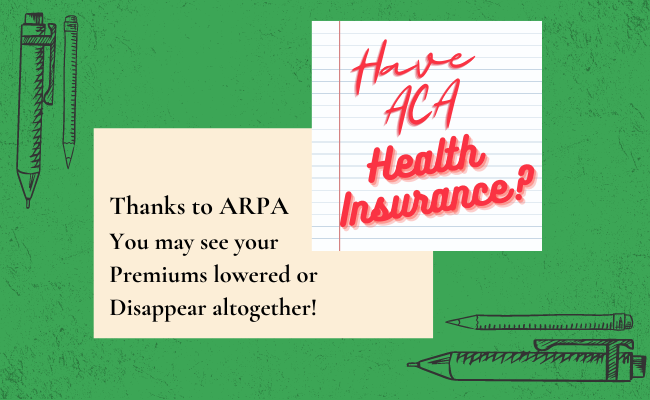ARPA Ends Subsidy for Health Insurance Premium Tax Credit
A brief history on the ACA
By now we have all heard of the Affordable care act (ACA)/Obamacare/Market Place, yes? If you haven’t you may have been living under a rock! (I kid!) Or at least lucky enough to have your health care provided by an employer and spouse employer and you have never had to worry about this. (You are forgiven)
When this plan first battled its way through legislation, it was based on a sliding scale of your household income. Meaning any penny that comes through your front door is counted. Yours, your spouse, even your children’s income was taken into account. Much to the surprise of many who signed up for this in the first place.
To get around this income issue, (lets just call it that) many people short changed their income to get a lower rate and affordable insurance coverage. Sounds like a smart thing to do right? In order for the system to work properly the government would subsidize the difference between your income issue and the true cost of the plan. Sounds very generous of the government to do that, this was called the Premium Tax Credit (PTC).
What the PTC really means
As many, many American’s found out when they filed their taxes is that the PTC is based on your taxable income. Meaning, if you short changed your income issue to get a plan you could pay for on a monthly basis and that amount didn’t match your income, the PTC was taken away and you had to pay back that amount. Much to the chagrin of many taxpayers, this amounted to up to thousands of dollars.
2020 Taxes
Some of you who have had to pay this portion of your health insurance back may have noticed that on your 2020 taxes, that penalty was waived. This was in an effort to alleviate some of the financial burdens incurred due to the pandemic.
This was a great relief to many Americans struggling last year (Yay Government!)

Before 2021
Here is where the number crunching happened, to qualify for this plan your household income after all of the magical adjustments made to your income you were left with that is called the MAGI (the M doesn’t really stand for magical). You were required to pay up to 9.83 percent of your MAGI for PTC coverage (based on the cost of a silver benchmark plan), and the PTC would pay for the rest.
Like all things, the PTC had its parameters. The PTC was only available to those enrolled whose income issues were between 100 and 400% of the Federal Poverty line. Also known as the FPL (not the electric company)
If your MAGI was one dollar over 400 percent of the FPL for a family your size, you get no tax credit— instead, you suffer a “subsidy cliff.” Meaning, you were not only available for the credit you had to pay your insurance plan in full.
This is what the Federal Poverty Level looks like for this year:

|
Household Size |
400 Percent of Federal Poverty Level (2021) |
|
1 |
$51,040 |
|
2 |
$68,960 |
|
3 |
$86,880 |
|
4 |
$104,800 |
|
5 |
$122,720 |
| For each additional person, add |
$17,920 |
Here are some staggering statistics about healthcare coverage for those on the wrong side of the subsidy cliff (Think Wiley E. Coyote)
- An estimated 1.4 million people pay full price. They make more income that allotted by the PTC
- Another 3.4 million are uninsured because they refuse to pay the full cost.
- Another 3.3 million buy their individual health insurance outside the Health Insurance Marketplace.
That is about 8 million Americans that are affected one way or another by this subsidy cliff.
New Law
With the passage of the American Rescue Plan Act of 2021 (ARPA), Congress has temporarily abolished the PTC subsidy cliff.
For 2021 and 2022, Americans who earn over 400 percent of the FPL are required to pay no more than 8.5 percent of their MAGI for PTC health insurance. Regardless how high their income, they are entitled to a PTC to the extent the cost of the silver benchmark plan exceeds 8.5 percent of MAGI.
Let’s do some number crunching:
A married couple making $150,000 a year would not have qualified for the PTC. Now according to the new math, based on a silver plan in the Market place their insurance cost would have been $21,000 for the year.
This new law (at least for the next two years) removed the subsidy cliff and they are now entitled to the PTC. They are required to pay no more than $12,750 for PTC health insurance (8.5 percent x $150,000 = $12,750). Thus, they are entitled to a PTC of $8,500 ($21,000 – $12,500 = $8,500).
Paying Less, or Even Nothing
If your MAGI is less than 400 percent of the FPL, you are required to pay less than 8.5 percent of MAGI for PTC coverage, based on a sliding scale.
Those with MAGI of 150 percent or less of the FPL pay nothing for their coverage.
Biggest Beneficiaries
The biggest beneficiaries of this change are older people who must pay up to three times more for PTC coverage than younger enrollees.
Those with incomes just above the 400 percent of the FPL will get the largest subsidies. The benefit gradually phases out at higher incomes, as the benchmark silver premiums no longer cross the 8.5-percent-of-income threshold.
Estimating Your Credit
You can get an estimate of the PTC you qualify for under the new rules at the online Health Insurance Marketplace Calculator maintained by the Kaiser Family Foundation.
To obtain the premium subsidies, you must obtain your health insurance through the health insurance marketplace. If you’re married, you must file a joint tax return to obtain the subsidies.
A majority of states use the federal health insurance exchange. At www.healthcare.gov, the government will direct you to the proper place (federal marketplace or state exchange).

Enrollment Open through August 15, 2021
Ordinarily, you must apply for PTC during the open enrollment period, which occurs during the last several weeks of each year. Let’s face it, the last two years have been anything but ordinary. Due to the COVID-19 pandemic, the government established a special open enrollment period through August 15, 2021. Some states with their own marketplaces have adopted a slightly different special open enrollment period.
If you already have PTC coverage, you may be able to upgrade it if you now qualify for the PTC or a larger credit.
There are four levels of coverage: bronze, silver, gold, and platinum. Bronze plans have the lowest monthly premiums, but have the highest deductibles, copayments, and other cost sharing. Although the premium subsidies are based on the cost of a silver plan, you can choose any of the plan levels.
Something of Note: Not all states are allowing upgrades during the special enrollment period.





